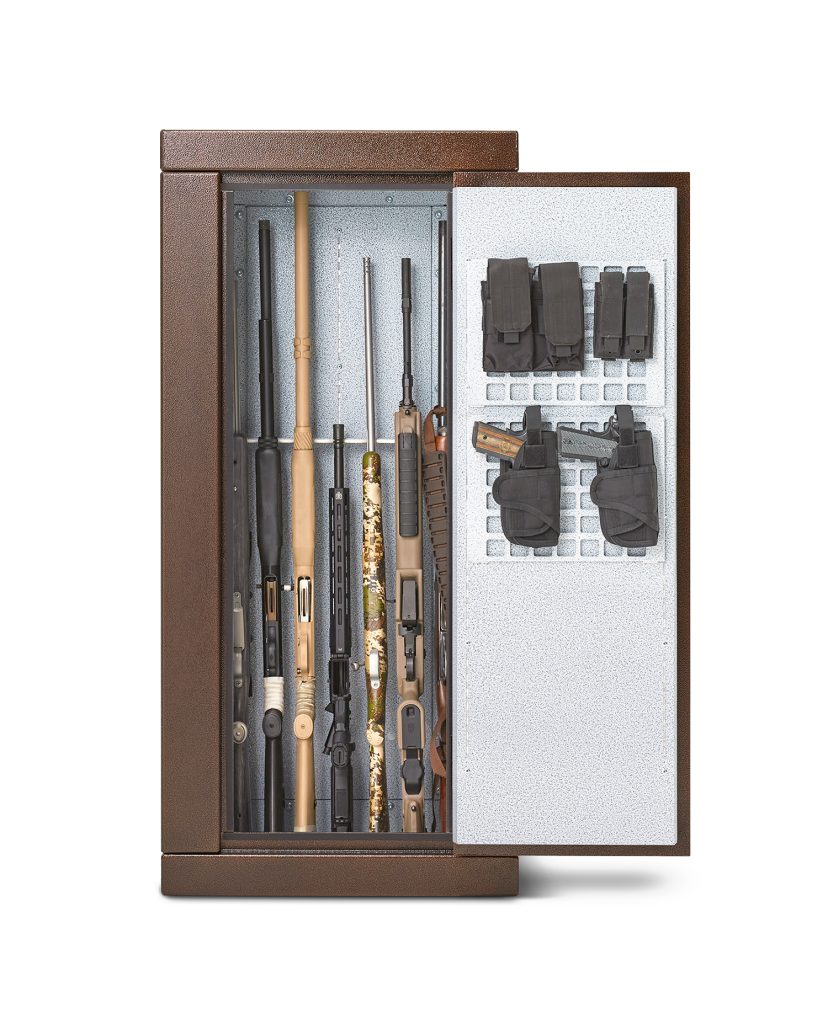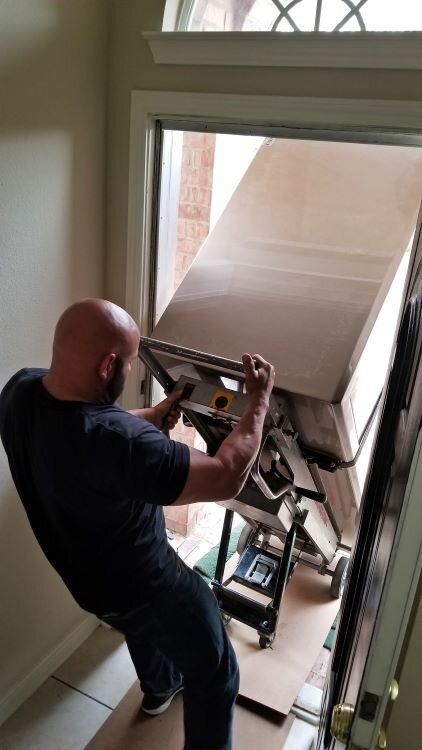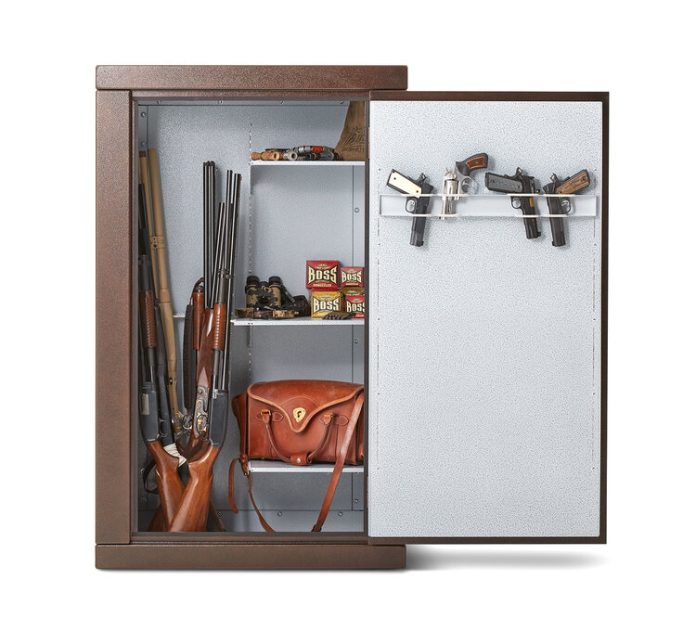Gun safes provide safe storage for firearms and other valuables. Safes can protect against theft, fire and unauthorized use. Safes are available in a wide variety of prices – with features and benefits that also vary widely. If purchased thoughtfully, gun safes can be an investment used over a lifetime and passed along to the next generation. Here are tips for purchasing the best gun safe for your needs.
1.Choose a safe size based on storage capacity and available space in your home
Determine how the size and number of firearms that will be secured in your safe. Long guns can often be stored uprights while smaller firearms can be placed on adjustable shelves or on a door panel. Consider bumping up to a larger safe if you think you’ll increase your collection over time. Think about other valuables like jewelry, heirlooms and important documents that could be safely stowed in the safe too. Balance storage needs with the space you have available for the safe.
Safe model numbers are often the safe width, the volume in cubic feet or the number of long guns that can be stowed. Compare actual dimensions because manufacturers markets gun capacity differently.
2. Pick an interior configuration option that works with your valuables
Think about how quickly you can access the safe and remove the firearm you want in an emergency situation. Gun rack configurations and adjustable shelves can be used to organize firearms safely while minimizing damage to metal, wood and scopes.
Some manufacturers, like Steelhead Outdoors, offer storage on the inside of the door panel to maximize storage within a gun safe.

3. Determine the best “hidden” space for safe placement
You don’t want to advertise to potential thieves that you have a safe filled with valuables. Storing your safe in a garage allows neighbors and passersby the opportunity to see the safe every time your garage door is open. Basements and closets are often good locations for a gun safe. Keep in mind that the floor structure must be able to support the weight of the safe and its contents. While moving a safe, you’ll need to make sure any stairs and door thresholds used during transport can handle the weight of the safe and usually two adult movers.
4. Decide what level of fire-insulation you prefer
Fire-insulated safes can withstand intense heat for a period time before heat enters the safe and impacts the contents. Some fire-insulated safes are designed with thick steel walls and special seals that expand to seal the safe’s door and keep fire out when temperatures rise dramatically. Fire protection is like theft protection in that nothing is invincible, but usually a more expensive safe provides more time.
Be aware that safe manufacturers use different testing methods and ratings – and every fire is different. No industry-standard time and temperature ratings have been established nor have consistent testing methods been determined and approved by an independent third-party lab or testing facility.
7. Determine how you’ll handle moving the safe
Heavy fire-insulated safes are difficult and dangerous to move. Many safes can weigh 600-1,500 lbs. Modular gun safes are a good option for installing and moving a gun safe. Two people can assemble, disassemble and move modular safe panels more easily when the gun safe needs to be relocated. Steelhead Outdoors’ modular safe panels can weigh less than 100 pounds. Unauthorized people can’t disassemble a Steelhead Outdoors safe to gain access because the safe is assembled with hardware only accessible from the inside of the safe, so it can only be disassembled after the door is opened.
According to moving industry data, a moving company may charge a customer an extra $165-$535 to move a traditional safe. If you attempt to move a traditional by yourself or with friends, there is a risk of physical harm. It’s important to consider the safe weight on stairs, floors and vehicles so they aren’t damaged.
If you plan to change residences or pass along the safe to another person, how you’ll move the safe is an important consideration.

8. Decide if you need to also purchase a dehumidifier
Moisture damage and corrosion prevention is important for protecting safe contents. Standard drywall is used as a fire insulator in traditional gun safes. Trapped moisture in the drywall will boil off when there’s a fire. While it can perform well in fire testing, it causes some corrosion issues in everyday use. The trapped moisture can be slowly released within the safe potentially causing rust and corrosion to valuable contents. This is the primary reason dehumidifier use is so common inside gun safes.
Eliminating the need for a dehumidifier that requires electricity can sometimes be achieved by using different construction methods and materials. Steelhead Outdoors safes feature a unique, patent-pending construction using of a two-stage insulation system. This insulation system doesn’t trap any moisture, so it can’t give off moisture during everyday use or fill the safe with steam during a fire. A dry ceramic fiber insulation rated to 2300 degrees F is combined with an interior metal panel with a radiant heat reflecting coating on the backside to create these unique insulating benefits.
9. Select a secure locking mechanism
Although no safe is theft-proof, safe manufacturers incorporate additional security features to thwart attackers and buy valuable time. High quality gun safes typically use either a mechanical or electronic lock. The type of locking mechanism is truly a personal preference. Electronic locks are becoming more popular. Steelhead Outdoors offers both mechanical and electronic locks.
10. Check your insurance policy for requirements and potential discounts
Some insurance companies offer a discount if a gun safe is used to store firearms and valuables. Also note that some insurance companies require that guns be stored in a gun safe. This tends to be the case if a higher value firearm is insured, and you want full coverage
Gun safes provide security, peace of mind and should be considered a long-term investment. Research if your local authority requires that guns be stowed in a firearm safe to make sure you are adhering to local regulations when selecting a gun security system. With some careful research you can find the best gun safe solution for your current and future needs.

